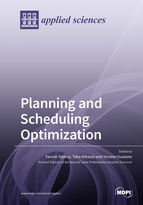Planning and Scheduling Optimization
A special issue of Applied Sciences (ISSN 2076-3417). This special issue belongs to the section "Applied Industrial Technologies".
Deadline for manuscript submissions: closed (28 February 2021) | Viewed by 52193
Special Issue Editors
Interests: planning and scheduling; optimal design of production and assembly lines; layout; transport optimization; reliability and maintenance optimization; heuristic and metaheuristic (genetic algorithm, ant colony, PSO, etc.); discrete optimization methods (mathematical programming, stochastic algorithms); multi objective optimization
Special Issues, Collections and Topics in MDPI journals
Interests: operations research; mathematical programming; metaheuristics
Special Issue Information
Dear Colleagues,
This Special Issue of Applied Sciences is devoted to recent research, current developments, and applications of complex systems planning and scheduling. This includes the principles and practice of the design, implementation, and analysis of exact and approximate optimization methods.
This Special Issue is also devoted to the optimization challenges of modern manufacturing, engineering, and healthcare systems. It also aims to present the most recent developments of operations research models and other applications of intelligent computing techniques used for planning and scheduling in a variety of manufacturing, engineering, and healthcare systems. The topics of interest include but are not limited to:
- Heuristic and metaheuristic algorithms for planning and scheduling problems in manufacturing, engineering and healthcare systems;
- Exact algorithms (brand and bounds, dynamic programming, etc.);
- Different scheduling applications (timetabling, network routing, crew scheduling, production scheduling, resource-constrained project scheduling, etc.);
- Energy-efficient planning and scheduling problems;
- Intelligent optimization approaches for intelligent manufacturing systems;
- Artificial Intelligence and data analytics (manufacturing, services, healthcare, services and industries of the future, etc.).
Prof. Farouk Yalaoui
Dr. Taha Arbaoui
Dr. Yassine Ouazene
Guest Editors
Manuscript Submission Information
Manuscripts should be submitted online at www.mdpi.com by registering and logging in to this website. Once you are registered, click here to go to the submission form. Manuscripts can be submitted until the deadline. All submissions that pass pre-check are peer-reviewed. Accepted papers will be published continuously in the journal (as soon as accepted) and will be listed together on the special issue website. Research articles, review articles as well as short communications are invited. For planned papers, a title and short abstract (about 100 words) can be sent to the Editorial Office for announcement on this website.
Submitted manuscripts should not have been published previously, nor be under consideration for publication elsewhere (except conference proceedings papers). All manuscripts are thoroughly refereed through a single-blind peer-review process. A guide for authors and other relevant information for submission of manuscripts is available on the Instructions for Authors page. Applied Sciences is an international peer-reviewed open access semimonthly journal published by MDPI.
Please visit the Instructions for Authors page before submitting a manuscript. The Article Processing Charge (APC) for publication in this open access journal is 2400 CHF (Swiss Francs). Submitted papers should be well formatted and use good English. Authors may use MDPI's English editing service prior to publication or during author revisions.
Keywords
- planning
- scheduling
- exact and approximate methods
- intelligent manufacturing systems
- healthcare systems
- logistics systems






